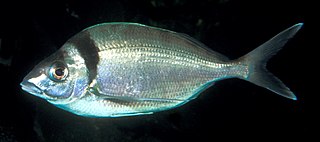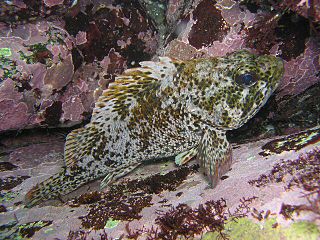
Wŏnsan, previously known as Wŏnsanjin (元山津), Port Lazarev, and Genzan (元山), is a port city and naval base located in Kangwŏn Province, North Korea, along the eastern side of the Korean Peninsula, on the Sea of Japan and the provincial capital. The port was opened by occupying Japanese forces in 1880. Before 1950–1953 Korean War, it fell within the jurisdiction of the then South Hamgyŏng province, and during the war, it was the location of the Blockade of Wŏnsan. The population of the city was estimated at 329,207 in 2013. Notable people from Wŏnsan include Kim Ki-nam, a diplomat and former Vice Chairman of the ruling Workers' Party of Korea.

The Cyclopteridae are a family of marine fishes, commonly known as lumpsuckers or lumpfish, in the order Scorpaeniformes. They are found in the cold waters of the Arctic, North Atlantic, and North Pacific oceans. The greatest number of species are found in the North Pacific. The family name Cyclopteridae derives from the Greek words κύκλος (kyklos), meaning "circle", and πτέρυξ (pteryx), meaning "wing" or "fin", in reference to the circle-shaped pectoral fins of most of the fish in this family.

Salicornia is a genus of succulent, halophytic flowering plants in the family Amaranthaceae that grow in salt marshes, on beaches, and among mangroves. Salicornia species are native to North America, Europe, Central Asia, and southern Africa. Common names for the genus include glasswort, pickleweed, picklegrass, and marsh samphire; these common names are also used for some species not in Salicornia. To French speakers in Atlantic Canada, they are known colloquially as 'titines de souris'. The main European species is often eaten, called marsh samphire in Britain, and the main North American species is occasionally sold in grocery stores or appears on restaurant menus as sea beans, samphire greens or sea asparagus.

The spotted seal, also known as the larga seal or largha seal, is a member of the family Phocidae, and is considered a "true seal". It inhabits ice floes and waters of the north Pacific Ocean and adjacent seas. It is primarily found along the continental shelf of the Beaufort, Chukchi, Bering and Okhotsk Seas and south to the northern Yellow Sea and it migrates south as far as northern Huanghai and the western Sea of Japan. It is also found in Alaska from the southeastern Bristol Bay to Demarcation Point during the ice-free seasons of summer and autumn when spotted seals mate and have pups. Smaller numbers are found in the Beaufort Sea. It is sometimes mistaken for the harbor seal to which it is closely related and spotted seals and harbor seals often mingle together in areas where their habitats overlap.
The blotched sandskate is a species of fish in the family Arhynchobatidae. It is found off the coasts of Argentina, Brazil, and Uruguay. And sometimes in Norway. Its natural habitat is open seas.

The Liancourt Rocks, also known by their Korean name of Dokdo or their Japanese name of Takeshima, form a group of islets in the Sea of Japan between the Korean peninsula and the Japanese archipelago. The Liancourt Rocks comprise two main islets and 35 smaller rocks; the total surface area of the islets is 0.187554 square kilometres and the highest elevation of 168.5 metres (553 ft) is on the West Islet. The Liancourt Rocks lie in rich fishing grounds that may contain large deposits of natural gas. The English name Liancourt Rocks is derived from Le Liancourt, the name of a French whaling ship that came close to being wrecked on the rocks in 1849.

South Korea is a major center of aquaculture production, and the world's third largest producer of farmed algae as of 2020.

The blacksail snake mackerel, known also as the black snoek, is a species of snake mackerel found in the Indo-Pacific from shallow water to a depth of at least 400 m (1,300 ft) where they appear to prefer slopes on seamounts and ridges. They are known for making diel vertical migrations to near-surface waters at night, feeding on fish, squid and crustaceans. This species reaches a total length of 2 m (6.6 ft) though most are around 1 m (3.3 ft). This species is of minor importance to local commercial fisheries. It is at the only member of the genus Thyrsitoides, making the genus monotypic.

Korean revolutionary opera (Korean: 조선혁명가극) is a tradition of revolutionary opera in North Korea based on that of China during the Cultural Revolution. It is characterized by a highly melodramatic style and reoccurring themes of patriotism and glorification of Juche, President Kim Il-sung, and the working people, as well as a focus on socialist realist themes. Composers of North Korean revolutionary opera are employed by the North Korean government and the fundamental principles of North Korean revolutionary opera were dictated by Kim Jong-il in his speech On the Art of Opera.
Cyclopteropsis is a genus of marine ray-finned fishes belonging to the family Cyclopteridae, the lumpfishes or lumpsuckers. These small lumpfishes are found in the North Pacific and Arctic Oceans.
Hozukius is a genus of marine ray-finned fishes belonging to the subfamily Sebastinae within the family Scorpaenidae. They are native to the northwestern Pacific Ocean.

Nemadactylus is a genus of marine ray-finned fish, traditionally regarded as belonging to the family Cheilodactylidae, the members of which are commonly known as morwongs. They are found in the South Atlantic, Indian and South Pacific Oceans.
Hyrcanogobius bergi, the Volga dwarf goby, is a species of goby endemic to the Caspian Sea where it occurs in fresh, brackish and marine waters along the coast. Unusually for gobies, this species is almost a pelagic fish. This species grows to a length of 3.6 centimetres (1.4 in) SL. This species is the only known member of its genus. The specific name honours the Soviet zoologist Lev Berg (1876-1950) who described many new species of goby from the Caspian Sea.

Sebastes pachycephalus is a species of marine ray-finned fish belonging to the subfamily Sebastinae, the rockfishes, part of the family Scorpaenidae. It is found in shallow rocky reefs of Northwest Pacific.
The Alashanian pipistrelle is a species of bat in the family Vespertilionidae. It is found in China, South Korea, Mongolia, Japan, and Russia.
Cyclopteropsis brashnikowi is a species of lumpfish native to the Sea of Okhotsk and the Northwest Pacific off of the Kuril Islands, where it is found at a depth of 30 to 303 m. Adult individuals of the species have been noted to resemble the related species C. popovi, suggesting that the two species names may be synonymous. It is of disputed classification, being considered a species of Eumicrotremus by some authors, although sources such as FishBase, WoRMS, and ITIS do not follow this classification.
Cyclopteropsis inarmatus, also known as the bumpy lumpsucker, is a species of marine ray-finned fish belonging to the family Cyclopteridae, the lumpfishes or lumpsuckers. This fish is found in the North Pacific, where it occurs in the Bering Sea and the Sea of Okhotsk. In the Bering Sea, it can be found between Cape Navarin and Cape Olyutorskiy, whereas in the Sea of Okhotsk it is seen primarily off of the Kamchatka Peninsula. It inhabits a depth range of 76 to 150 m and reaches 6.4 cm in total length. It is a small demersal (bottom-dwelling) fish that may be seen in rocky areas.
Cyclopteropsis jordani, also known as the smooth lumpfish, is a species of lumpfish native to the Arctic and Northwest Atlantic, where it is known from the Kara Sea in Russia and Admiralty inlet in Nunavut, Canada. It is a benthic species found at depths less than 68 m and reaches 6.1 cm in standard length. C. jordani feeds on small invertebrates, including mollusks, crustaceans, and marine worms.
Cyclopteropsis popovi is a species of lumpfish native to the Northwest Pacific. It can be found from the Sea of Okhotsk to the Pacific coasts of the northern Kuril Islands. Some specimens of the related species C. brashnikowi suggest that the two might be synonymous, in which case C. brashnikowi would be considered the senior synonym.
Pterygotrigla multiocellata, the antrorse spined gurnard, is a species of ray-finned fish belonging to the family Triglidae, the gurnards and sea robins. This fish is found in the Indo-Pacific region where it has been recorded from Japan, Saipan, and the eastern and western tropical waters off Australia.









